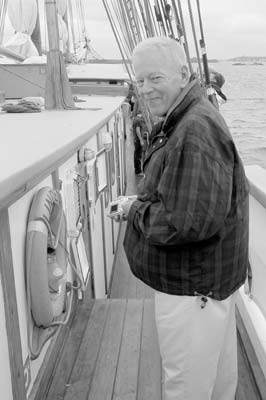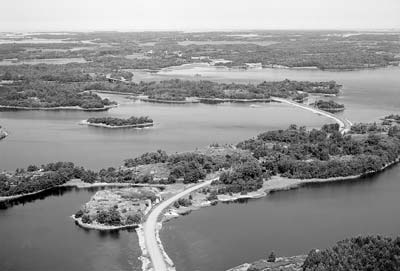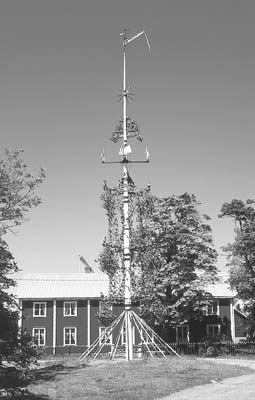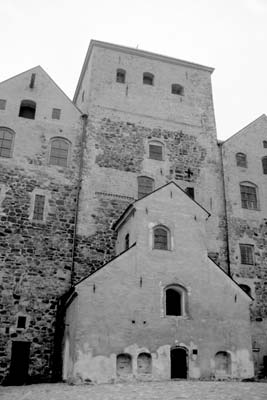Finland’s King’s Road West
by Jay Brunhouse
Pilgrims, royal couriers, soldiers, merchants, postmen and even Czar Alexander I trudged along the muddy, medieval path that connected Stockholm through southern Finland with St. Petersburg. It has become known as Finland’s King’s Road because the crown maintained it. The Russian emperor traveled in an ermine fur-lined sledge from Turku to Helsinki with only one night’s sleep, although at the time it took the common folk three days.
The King’s Road is one of the oldest roads in Finland, but it is not only its history that makes it so interesting. It was the primary artery between the cultures of the East and West, and the differences were reflected in the transition of the people’s behavior, language, speech, attitude and environment.
Records show that the King’s Road became as important as the water route by at the end of the 14th century. It was passable by foot or horseback, but in winter it was easier to travel by sledge.
By 14th-century law, the road’s width was set at nearly 20 feet; however, the path was usually narrower through hilly country. It was ditched on both sides and edged with rock. The forest was cut down 20 to 25 feet from the road so that the sun and wind could dry it.
Until the 16th century, the road was a riding path and merchandise was transported by packhorse or strung between two poles on a cloth. The postal system was set up in 1638-1643, and by the end of the century mail was transported regularly. At first the mail was carried on foot, but as early as the 1640s horses were used. Mail sent from Turku on Sunday arrived in Vyborg, Russia, on Wednesday evening, except when it took a week.
The construction of the railroad at the beginning of the 20th century relegated the road to local transportation, as it was more convenient to make long trips by steam train. Horses then gave way to autos and, in the 1920s, buses.
Now visitors and residents drive Volvo sports cars and ride high-speed Pendolino trains, but they still seek out markers and visit the interesting series of sights dating from the heyday of the King’s Road, including Turku Castle. The staffs of the tourist offices in Turku and Helsinki are eager to help them with their exploration by car, bus or train.
Åland Islands
The Åland Islands (say “Oh-land” — visit www.visitaland.com) were the stepping stones between Sweden and Russia. Åland consists of more than 6,500 pristine islands and skerries with fresh air and absolute quietness. It is forested with occasionally dense birch trees, and you see scattered farmhouses and shops. Bridges and ferries provide free service between the 60 inhabited islands for vacationers who hop between islands by bike, car or small outboard motorboat.
Couriers and mail carriers rode north from Stockholm to the Swedish port of Grisslehamn and from there crossed 28 miles by boat to Eckerö in the Åland Islands. It was the shortest-possible crossing. When they could not sail, they crossed the ice by horses and sledges. When the ice did not carry, they crossed the sea by pulling the boat over the ice.
Russian Grand Duchy
Åland became Russian after the Swedish-Russian war. The Russian state built the 1828 post office building and customs house at Eckerö as a dignified westernmost outpost of the Russian empire on the Baltic Sea. Eckerö, Finland’s largest village, became the Gateway to Russia. You can visit interesting museums in the structures (www.goaland.net/post&tullhus and www.goaland.net/postrotemuseum) designed by architect Carl Ludwig Engle in the Empire style of Helsinki and St. Petersburg.
After Finland’s independence, the Åland Islands became an autonomous region of Finland. The residents still speak Swedish with an Åland dialect and fly their own flag and use their own postage stamps, but Helsinki determines their foreign policy.
Nowadays, you can duplicate the postal route aboard Eckerö Lines’ (www.eckerolinjen.fi) 2-hour crossing from Grisslehamn to Eckerö. Alternately, cross aboard Viking Line’s (www.vikingline.fi) M/S Ålandsfärjan from Kapellskär, Sweden, to Mariehamn and thence the Viking Line’s M/S Amorella or M/S Isabella to Turku.
Åland’s only city, Mariehamn, was founded in 1861 by Czar Alexander II and named after his consort, Czarina Maria Alexandrowna, after Åland became part of the Russian Grand Duchy of Finland. At that time, the town had 35 inhabitants. It has grown to 10,700 and has become Åland’s capital and principal port. It is a small city on a not-so-small island.
Mariehamn sits on a hilly, _-mile-wide isthmus. From Mariehamn’s center, you can walk 10 minutes to the Western Harbor on one side and take a slightly longer walk to the Eastern Harbor on the opposite side.
Just north of the Eastern Harbor you find Mariehamn’s Maritime Quarter (www.sjokvarteret.com), which is a thriving marine center with boat building, a blacksmith and facilities for other traditional handicrafts. The fascinating Åland Maritime Museum contains exhibitions of ship and boat building in former times as well as present and an exhibition of the farm boats that were used for crossings to and from Sweden. You can also browse a museum shop and enjoy a snack at the café.
Turku
From Åland, the King’s Road winds though nearly unbroken forests to Turku (www.turkutouring.fi), the birthplace of Finnish culture and Finland’s then-largest city, ending near Turku Cathedral, which was consecrated in 1300 and has become the symbol of the city. During Swedish rule, the Turku post office was the biggest and most important in Finland.
Gray-stone Turku Castle guards the mouth of the Aura River. The castle’s history goes back to the 1280s when it was merely the fortified headquarters built for the royal governor of Finland and his troops. In the course of centuries, the site was gradually expanded into a massive castle that reached its heyday in the mid-16th century.
You can visit the castle’s exhibitions, which not only illustrate the history of Turku and Finland but also show the dress, customs and interior decoration of past centuries. Docents also arrange theme exhibitions, concerts and events, making it the most-visited museum in Finland.
In addition to the castle and cathedral, Turku highlights include the Luostarinmäki Open Air Museum and the Aboa Vetus (Old Turku) and Ars Nova (Contemporary Art) museums. The handsome promenade beside the Aura River is an attractive place to relax. Turku also boasts some lively pubs. You can hoist a few and meet the locals at The Bank, Pharmacy and The Toilet.
I thank the Finnish Tourist Board (www.visitfinland.com) as well as the Äland and Turku tourism authorities for their hospitality. I stayed at the Scanic Hotel Savoy Mariehamn, which is a stone’s throw from the harbor, and the Scanic Plaza Hotel Turku, which is centrally located for shopping and pub hopping. Both can be found at www.scandic-hotels.com.
I recommend, for reference, “The Mail Road Across Land and Sea,” Postal Museum Publication No. 53 (Stockholm, 2004).





